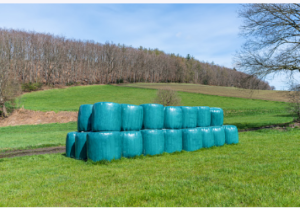Silage wrap is a type of plastic film used to seal hay bales. It prevents moisture, oxygen and heat from entering the bales, preserving the quality of the silage.
It can be made from different layers, varying in thickness and strength. It may also include a UV stabiliser and be impermeable to water vapour.
 It prevents moisture from entering the bales
It prevents moisture from entering the bales
Silage wrap prevents moisture from entering the bales by sealing in the air with layers of plastic film. The film aims to limit oxygen from entering the bales, which keeps microorganisms from consuming nutrients in the hay and causing spoilage.
A good quality silage wrap will have UV stabilisers added to the material to prevent it from fading from the sun. It is a necessary feature to ensure the product stays in good condition for a long time.
The number of layers on the film will also determine how well it prevents moisture from entering the bales. Generally, 6-8 layers are adequate to secure the haylage. The barrier’s thickness is also a factor, with thicker barriers providing better protection.
There is some debate about how much plastic to use when wrapping bales. Some people believe that a few layers are sufficient, but others feel that more is better.
Regarding the amount of film, the answer depends on the type of crop and the weather conditions where it will be stored. For example, higher-moisture hay requires a thicker barrier to keep moisture from getting in, but lower-moisture hay can get away with just two or three layers.
Delaying the wrapping of the bales can affect the final quality of the silage. For example, research has shown that baled annual ryegrass forage with 30% moisture increased pH, decreased organic acids, and increased lactic acid with delayed wrapping. Similarly, bales at 74% moisture had increased butyric acid with delayed wrapping.
The results of these experiments indicate that reducing the time between baling and wrapping can help improve the final quality of silage. It is especially important if bales are too wet or dry when wrapping. It can lead to clostridial fermentation that produces a high level of butyric acid and ammonia.
It prevents oxygen from entering the bales
The oxygen barrier in silage wrap is vital for reducing feed spoilage and maintaining the feed’s nutritional value. If oxygen is allowed to enter the bale, bacterial and fungal growth will occur, leading to decreased dry matter (DM) levels and reduced feed quality.
The most effective way to prevent oxygen from entering a bale is to ensure that the number of layers of plastic used to wrap it is sufficient. The thickness of the plastic is also critical for preventing air from entering the bales. A minimum of 6 mils – preferably eight mils – of plastic is required for proper wrapping to protect the bale.
One of the main reasons a bale of hay can be spoiled is because microorganisms within the hay have access to enough oxygen to eat up nutrients and generate heat and water vapour. Limiting the amount of oxygen in the bale makes these microorganisms dormant and doesn’t consume nutrients.
Bales must be wrapped as soon as possible, ideally within four hours of being baled. It helps prevent excessive heating and aerobic deterioration and minimises bale deformations that can affect the plastic’s integrity.
During the wrapping process, multiple layers of silage film are needed to maintain the integrity of the plastic and prevent air from entering the bale. Therefore, a multi-layer structure of five or more layers is often recommended for optimal results.
The most effective way to minimise oxygen leakage into a bale is to use a high-quality silage wrap made from metallocene polyethylene or LLDPE, providing a solid and durable barrier to oxygen. A quality silage wrap will also include UV stabilisers to help withstand long periods of direct sunlight, which can damage ordinary plastic and deteriorate it.
It prevents moisture from accumulating on the bales
Silage wrap helps farmers prevent water from getting on the bales by locking out air, one of the leading causes of spoilage. When air enters a bale, microorganisms can live and breathe, consuming nutrients from the crop and creating heat and water vapour that damages the forage. It leads to a loss of nutritional value and quality.
The best way to avoid this is by wrapping the bales as soon as they are cut. This way, they will be less likely to develop mould and other diseases because the microorganisms won’t have any oxygen to feed on.
A key factor to consider when wrapping bales is the per cent moisture at harvest time. Ideally, moisture should be between 40 and 55 per cent to provide the ideal conditions for proper fermentation and longer-term storage.
To reduce the amount of moisture accumulated on the bales, it is important to wrap them as soon as they are cut. It will ensure that they won’t be damaged by moisture and will preserve the hay for longer.
It is also essential to ensure that the wrappers used for wrapping the bales can handle their weight. It is because the heavier the bales are, the more difficult they are to manage.